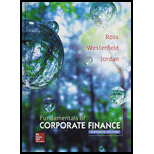
Fundamentals of Corporate Finance with Connect Access Card
11th Edition
ISBN: 9781259418952
Author: Stephen A. Ross Franco Modigliani Professor of Financial Economics Professor, Randolph W Westerfield Robert R. Dockson Deans Chair in Bus. Admin., Bradford D Jordan Professor
Publisher: McGraw-Hill Education
expand_more
expand_more
format_list_bulleted
Concept explainers
Textbook Question
Chapter 9, Problem 8QP
Calculating
Expert Solution & Answer
Want to see the full answer?
Check out a sample textbook solution
Students have asked these similar questions
What is the difference between a contra asset account and a liability?i need help.
What is the significance of a company’s price-to-earnings (P/E) ratio? i need answer.
What is the significance of a company’s price-to-earnings (P/E) ratio?
Chapter 9 Solutions
Fundamentals of Corporate Finance with Connect Access Card
Ch. 9.1 - Prob. 9.1ACQCh. 9.1 - Prob. 9.1BCQCh. 9.2 - Prob. 9.2ACQCh. 9.2 - Why do we say that the payback period is, in a...Ch. 9.3 - Prob. 9.3ACQCh. 9.3 - What advantage(s) does the discounted payback have...Ch. 9.4 - What is an average accounting rate of return...Ch. 9.4 - What are the weaknesses of the AAR rule?Ch. 9.5 - Prob. 9.5ACQCh. 9.5 - Is it generally true that an advantage of the IRR...
Ch. 9.6 - What does the profitability index measure?Ch. 9.6 - How would you state the profitability index rule?Ch. 9.7 - Prob. 9.7ACQCh. 9.7 - If NPV is conceptually the best procedure for...Ch. 9 - Prob. 9.1CTFCh. 9 - Prob. 9.2CTFCh. 9 - Prob. 9.3CTFCh. 9 - Prob. 9.4CTFCh. 9 - What is a benefitcost ratio?Ch. 9 - Prob. 9.7CTFCh. 9 - Prob. 1CRCTCh. 9 - Net Present Value [LO1] Suppose a project has...Ch. 9 - Prob. 3CRCTCh. 9 - Prob. 4CRCTCh. 9 - Prob. 5CRCTCh. 9 - Net Present Value [LO1] Concerning NPV: a....Ch. 9 - Prob. 7CRCTCh. 9 - Profitability Index [LO7] Concerning the...Ch. 9 - Payback and Internal Rate of Return [LO2, 5] A...Ch. 9 - Prob. 10CRCTCh. 9 - Capital Budgeting Problems [LO1] What difficulties...Ch. 9 - Prob. 12CRCTCh. 9 - Modified Internal Rate of Return [LO6] One of the...Ch. 9 - Net Present Value [LO1] It is sometimes stated...Ch. 9 - Internal Rate of Return [LO5] It is sometimes...Ch. 9 - Calculating Payback [LO2] What is the payback...Ch. 9 - Calculating Payback [LO2] An investment project...Ch. 9 - Calculating Payback [LO2] Siva, Inc., imposes a...Ch. 9 - Calculating Discounted Payback [LO3] An investment...Ch. 9 - Calculating Discounted Payback [LO3] An investment...Ch. 9 - Calculating AAR [LO4] Youre trying to determine...Ch. 9 - Calculating IRR [LO5] A firm evaluates all of its...Ch. 9 - Calculating NPV [LO1] For the cash flows in the...Ch. 9 - Calculating NPV and IRR [LO1, 5] A project that...Ch. 9 - Calculating IRR [LO5] What is the IRR of the...Ch. 9 - Prob. 11QPCh. 9 - NPV versus IRR [LO1, 5] Garage, Inc., has...Ch. 9 - Prob. 13QPCh. 9 - Problems with IRR [LO5] Light Sweet Petroleum,...Ch. 9 - Prob. 15QPCh. 9 - Problems with Profitability Index [LO1, 7] The...Ch. 9 - Comparing Investment Criteria [LO1, 2, 3, 5, 7]...Ch. 9 - NPV and Discount Rates [LO1] An investment has an...Ch. 9 - MIRR [L06] RAK Corp. is evaluating a project with...Ch. 9 - Prob. 20QPCh. 9 - Prob. 21QPCh. 9 - Cash Flow Intuition [LO1, 2] A project has an...Ch. 9 - Payback and NPV [LO1, 2] An investment under...Ch. 9 - Prob. 24QPCh. 9 - NPV Valuation [LO1] The Yurdone Corporation wants...Ch. 9 - Problems with IRR [LO5] A project has the...Ch. 9 - Problems with IRR [LO5] McKeekin Corp. has a...Ch. 9 - Prob. 28QPCh. 9 - Prob. 1MCh. 9 - Prob. 2MCh. 9 - Bullock Gold Mining Seth Bullock, the owner of...
Knowledge Booster
Learn more about
Need a deep-dive on the concept behind this application? Look no further. Learn more about this topic, finance and related others by exploring similar questions and additional content below.Similar questions
arrow_back_ios
SEE MORE QUESTIONS
arrow_forward_ios
Recommended textbooks for you
 Essentials Of InvestmentsFinanceISBN:9781260013924Author:Bodie, Zvi, Kane, Alex, MARCUS, Alan J.Publisher:Mcgraw-hill Education,
Essentials Of InvestmentsFinanceISBN:9781260013924Author:Bodie, Zvi, Kane, Alex, MARCUS, Alan J.Publisher:Mcgraw-hill Education,

 Foundations Of FinanceFinanceISBN:9780134897264Author:KEOWN, Arthur J., Martin, John D., PETTY, J. WilliamPublisher:Pearson,
Foundations Of FinanceFinanceISBN:9780134897264Author:KEOWN, Arthur J., Martin, John D., PETTY, J. WilliamPublisher:Pearson, Fundamentals of Financial Management (MindTap Cou...FinanceISBN:9781337395250Author:Eugene F. Brigham, Joel F. HoustonPublisher:Cengage Learning
Fundamentals of Financial Management (MindTap Cou...FinanceISBN:9781337395250Author:Eugene F. Brigham, Joel F. HoustonPublisher:Cengage Learning Corporate Finance (The Mcgraw-hill/Irwin Series i...FinanceISBN:9780077861759Author:Stephen A. Ross Franco Modigliani Professor of Financial Economics Professor, Randolph W Westerfield Robert R. Dockson Deans Chair in Bus. Admin., Jeffrey Jaffe, Bradford D Jordan ProfessorPublisher:McGraw-Hill Education
Corporate Finance (The Mcgraw-hill/Irwin Series i...FinanceISBN:9780077861759Author:Stephen A. Ross Franco Modigliani Professor of Financial Economics Professor, Randolph W Westerfield Robert R. Dockson Deans Chair in Bus. Admin., Jeffrey Jaffe, Bradford D Jordan ProfessorPublisher:McGraw-Hill Education

Essentials Of Investments
Finance
ISBN:9781260013924
Author:Bodie, Zvi, Kane, Alex, MARCUS, Alan J.
Publisher:Mcgraw-hill Education,



Foundations Of Finance
Finance
ISBN:9780134897264
Author:KEOWN, Arthur J., Martin, John D., PETTY, J. William
Publisher:Pearson,

Fundamentals of Financial Management (MindTap Cou...
Finance
ISBN:9781337395250
Author:Eugene F. Brigham, Joel F. Houston
Publisher:Cengage Learning

Corporate Finance (The Mcgraw-hill/Irwin Series i...
Finance
ISBN:9780077861759
Author:Stephen A. Ross Franco Modigliani Professor of Financial Economics Professor, Randolph W Westerfield Robert R. Dockson Deans Chair in Bus. Admin., Jeffrey Jaffe, Bradford D Jordan Professor
Publisher:McGraw-Hill Education
Capital Budgeting Introduction & Calculations Step-by-Step -PV, FV, NPV, IRR, Payback, Simple R of R; Author: Accounting Step by Step;https://www.youtube.com/watch?v=hyBw-NnAkHY;License: Standard Youtube License